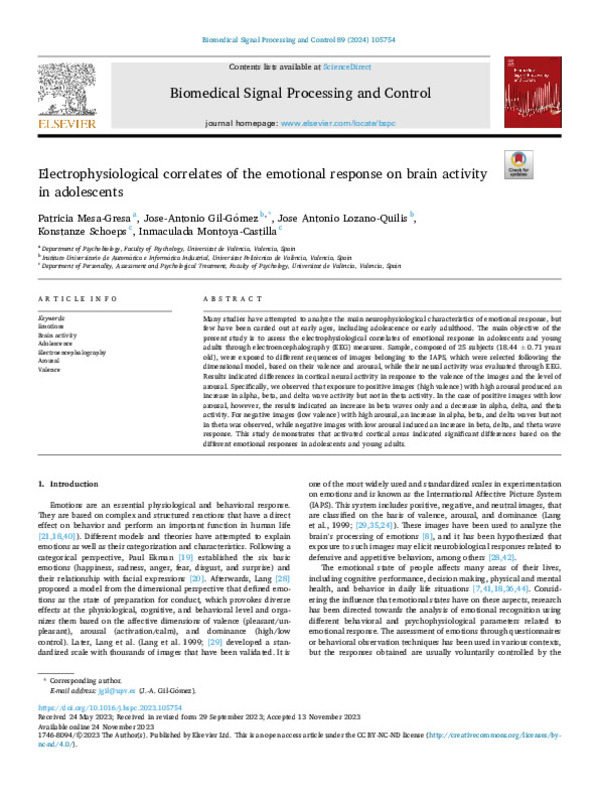JavaScript is disabled for your browser. Some features of this site may not work without it.
Buscar en RiuNet
Listar
Mi cuenta
Estadísticas
Ayuda RiuNet
Admin. UPV
Electrophysiological correlates of the emotional response on brain activity in adolescents
Mostrar el registro sencillo del ítem
Ficheros en el ítem
| dc.contributor.author | Mesa Gresa, Patricia
|
es_ES |
| dc.contributor.author | Gil-Gómez, José-Antonio
|
es_ES |
| dc.contributor.author | Lozano Quilis, José Antonio
|
es_ES |
| dc.contributor.author | Schoeps, Konstanze
|
es_ES |
| dc.contributor.author | Montoya-Castilla, Inmaculada
|
es_ES |
| dc.date.accessioned | 2023-12-18T19:03:51Z | |
| dc.date.available | 2023-12-18T19:03:51Z | |
| dc.date.issued | 2023-11-24 | es_ES |
| dc.identifier.issn | 1746-8094 | es_ES |
| dc.identifier.uri | http://hdl.handle.net/10251/200853 | |
| dc.description.abstract | [EN] Many studies have attempted to analyze the main neurophysiological characteristics of emotional response, but few have been carried out at early ages, including adolescence or early adulthood. The main objective of the present study is to assess the electrophysiological correlates of emotional response in adolescents and young adults through electroencephalography (EEG) measures. Sample, composed of 25 subjects (18.44 ± 0.71 years old), were exposed to different sequences of images belonging to the IAPS, which were selected following the dimensional model, based on their valence and arousal, while their neural activity was evaluated through EEG. Results indicated differences in cortical neural activity in response to the valence of the images and the level of arousal. Specifically, we observed that exposure to positive images (high valence) with high arousal produced an increase in alpha, beta, and delta wave activity but not in theta activity. In the case of positive images with low arousal, however, the results indicated an increase in beta waves only and a decrease in alpha, delta, and theta activity. For negative images (low valence) with high arousal, an increase in alpha, beta, and delta waves but not in theta was observed, while negative images with low arousal induced an increase in beta, delta, and theta wave response. This study demonstrates that activated cortical areas indicated significant differences based on the different emotional responses in adolescents and young adults. | es_ES |
| dc.description.sponsorship | The authors would like to thank the sample participants for their contribution to the study. This publication is part of the project PSI2017- 84005-R funded by MCIN/ AEI/10.13039/501100011033/ and by FEDER Una manera de hacer Europa | es_ES |
| dc.language | Inglés | es_ES |
| dc.publisher | Elsevier | es_ES |
| dc.relation.ispartof | Biomedical Signal Processing and Control | es_ES |
| dc.rights | Reconocimiento - No comercial - Sin obra derivada (by-nc-nd) | es_ES |
| dc.subject | Emotions | es_ES |
| dc.subject | Brain activity | es_ES |
| dc.subject | Adolescence | es_ES |
| dc.subject | Electroencephalography | es_ES |
| dc.subject | Arousal | es_ES |
| dc.subject | Valence | es_ES |
| dc.subject.classification | LENGUAJES Y SISTEMAS INFORMATICOS | es_ES |
| dc.title | Electrophysiological correlates of the emotional response on brain activity in adolescents | es_ES |
| dc.type | Artículo | es_ES |
| dc.identifier.doi | 10.1016/j.bspc.2023.105754 | es_ES |
| dc.relation.projectID | info:eu-repo/grantAgreement/AEI/Plan Estatal de Investigación Científica y Técnica y de Innovación 2013-2016/PSI2017-84005-R/ES/INTERVENCION SOCIO-EMOCIONAL APOYADA EN TICS: DESARROLLO DE LA RESPONSABILIDAD Y EL BIENESTAR EN LA COMUNIDAD EDUCATIVA/ | es_ES |
| dc.rights.accessRights | Abierto | es_ES |
| dc.contributor.affiliation | Universitat Politècnica de València. Escuela Politécnica Superior de Gandia - Escola Politècnica Superior de Gandia | es_ES |
| dc.contributor.affiliation | Universitat Politècnica de València. Escuela Técnica Superior de Ingenieros Industriales - Escola Tècnica Superior d'Enginyers Industrials | es_ES |
| dc.description.bibliographicCitation | Mesa Gresa, P.; Gil-Gómez, J.; Lozano Quilis, JA.; Schoeps, K.; Montoya-Castilla, I. (2023). Electrophysiological correlates of the emotional response on brain activity in adolescents. Biomedical Signal Processing and Control. 89:1-11. https://doi.org/10.1016/j.bspc.2023.105754 | es_ES |
| dc.description.accrualMethod | S | es_ES |
| dc.relation.publisherversion | https://doi.org/10.1016/j.bspc.2023.105754 | es_ES |
| dc.description.upvformatpinicio | 1 | es_ES |
| dc.description.upvformatpfin | 11 | es_ES |
| dc.type.version | info:eu-repo/semantics/publishedVersion | es_ES |
| dc.description.volume | 89 | es_ES |
| dc.relation.pasarela | S\505522 | es_ES |
| dc.contributor.funder | Universitat de València | es_ES |
| dc.contributor.funder | European Regional Development Fund | es_ES |
| dc.subject.ods | 03.- Garantizar una vida saludable y promover el bienestar para todos y todas en todas las edades | es_ES |








